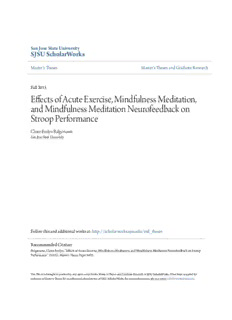
Effects of Acute Exercise, Mindfulness Meditation, and Mindfulness Meditation Neurofeedback on ... PDF
Preview Effects of Acute Exercise, Mindfulness Meditation, and Mindfulness Meditation Neurofeedback on ...
SSaann JJoossee SSttaattee UUnniivveerrssiittyy SSJJSSUU SScchhoollaarrWWoorrkkss Master's Theses Master's Theses and Graduate Research Fall 2015 EEffffeeccttss ooff AAccuuttee EExxeerrcciissee,, MMiinnddffuullnneessss MMeeddiittaattiioonn,, aanndd MMiinnddffuullnneessss MMeeddiittaattiioonn NNeeuurrooffeeeeddbbaacckk oonn SSttrroooopp PPeerrffoorrmmaannccee Claire Evelyn Balgemann San Jose State University Follow this and additional works at: https://scholarworks.sjsu.edu/etd_theses RReeccoommmmeennddeedd CCiittaattiioonn Balgemann, Claire Evelyn, "Effects of Acute Exercise, Mindfulness Meditation, and Mindfulness Meditation Neurofeedback on Stroop Performance" (2015). Master's Theses. 4621. DOI: https://doi.org/10.31979/etd.j63m-fmu3 https://scholarworks.sjsu.edu/etd_theses/4621 This Thesis is brought to you for free and open access by the Master's Theses and Graduate Research at SJSU ScholarWorks. It has been accepted for inclusion in Master's Theses by an authorized administrator of SJSU ScholarWorks. For more information, please contact [email protected]. EFFECTS OF ACUTE EXERCISE, MINDFULNESS MEDITATION, AND MINDFULNESS MEDITATION NEUROFEEDBACK ON STROOP PERFORMANCE A Thesis Presented to The Faculty of the Graduate Program in Human Factors and Ergonomics San José State University In Partial Fulfillment of the Requirements for the Degree Master of Science by Claire E. Balgemann December 2015 ©2015 Claire E. Balgemann ALL RIGHTS RESERVED The Designated Thesis Committee Approves the Thesis Titled EFFECTS OF ACUTE EXERCISE, MINDFULNESS MEDITATION, AND MINDFULNESS MEDITATION NEUROFEEDBACK ON STROOP PERFORMANCE by Claire E. Balgemann APPROVED FOR THE GRADUATE PROGRAM IN HUMAN FACTORS & ERGONOMICS DEPARTMENT OF INDUSTRIAL AND SYSTEMS ENGINEERING SAN JOSÉ STATE UNIVERSITY December 2015 Dr. Emily H. Wughalter Department of Kinesiology Dr. Sean Laraway Department of Psychology Dr. David Schuster Department of Psychology ABSTRACT EFFECTS OF ACUTE EXERCISE, MINDFULNESS MEDITATION, AND MINDFULNESS MEDITATION NEUROFEEDBACK ON STROOP PERFORMANCE by Claire E. Balgemann Empirical research has demonstrated that acute aerobic physical exercise, neurofeedback, and mindfulness meditation independently have positive effects on executive performance. Technology has enabled a new intervention that combines neurofeedback and mindfulness meditation; however its effects on executive function are unknown. The aim in the present study was to understand how executive function may be enhanced in healthy individuals. Forty-two participants were randomly assigned to one of three intervention groups: acute physical exercise, mindfulness meditation, or mindfulness meditation neurofeedback delivered via the Muse brain-sensing headband. Participants completed 50 trials of the Stroop task, a well-established measure of executive function. A statistically significant one-way ANOVA revealed that participants made fewer errors after undergoing the mindfulness meditation neurofeedback intervention than they did following acute physical exercise. These findings demonstrate that mindfulness meditation neurofeedback may boost aspects of executive function that relate to lower Stroop task error rates. ACKNOWLEDGMENTS I would first like to thank my thesis advisor, Dr. Emily H. Wughalter, for providing intellectual guidance while allowing me the freedom to develop my project independently. Thank you for your insightful comments throughout the versions of this thesis and for lending direction and cohesion to the final product. To my committee members, Dr. Sean Laraway and Dr. David Schuster, my sincere appreciation for your encouragement, ideas, and support. This work is substantially stronger as a result of your input and guidance. Thank you to Dr. Yasser Dessouky for helping me to find a space to complete a full day’s worth of data collection that happened to be scheduled during the university’s campus orientation day. Your willingness to assist an unknown graduate student saved the day. I would also like to thank my parents, who have always selflessly backed my education and whatever unusual pursuits attracted my interest. Thank you for giving me the freedom and confidence to explore so many different paths. Finally, my profound thanks to Güneş Kayacik, without whom I can honestly say I never would have gone back to school at all, let alone completed this thesis. Thank you for your encouragement, optimism, and patience throughout the planning, writing, analyzing, and agonizing that came with this thesis. v For Scott vi Table of Contents Introduction ......................................................................................................................... 1 Contributions of the study ............................................................................................... 3 Purpose of the study ........................................................................................................ 3 Definition of Terms ......................................................................................................... 4 Limitations ...................................................................................................................... 6 Delimitations ................................................................................................................... 6 Review of Literature ........................................................................................................... 8 Physical exercise ............................................................................................................. 8 Exercise type as a moderating variable…………………………………………..10 Exercise intensity as a moderating variable……………………………………...11 Participant fitness level as a moderating variable………………………………..13 Exercise activity as a moderating variable……………………………………….14 Timing of cognitive task as a moderating variable………………………………15 Type of cognitive task as a moderating variable………………………………...16 Mindfulness meditation ................................................................................................ 17 Historical background……………………………………………………………18 Practical applications of mindfulness meditation………………………………..19 Mindfulness meditation and cognitive performance……………………………..21 Neurofeedback .............................................................................................................. 24 Historical background……………………………………………………………25 Neurofeedback procedures……………………………………………………….26 Neurofeedback and cognitive performance……………………………………...28 Mindfulness meditation neurofeedback ........................................................................ 29 vii Summary of the Review of Literature .......................................................................... 30 Method .............................................................................................................................. 32 Design and Analysis of Data ......................................................................................... 33 Participants .................................................................................................................... 33 Measures ....................................................................................................................... 35 Instrumentation ............................................................................................................. 38 Stationary bicycle………………………………………………………………...38 Heart rate monitor………………………………………………………………..39 Muse brain-sensing headband……………………………………………………39 Muse Calm application…………………………………………………………..40 Stopwatch………………………………………………………………………...46 Tally counter……………………………………………………………………..46 Procedure ...................................................................................................................... 46 Results ............................................................................................................................... 50 Participants .................................................................................................................... 50 Effect of study interventions on Stroop task time ......................................................... 54 Effect of study interventions on Stroop task number of errors ..................................... 55 Summary of Results ...................................................................................................... 59 Discussion ......................................................................................................................... 60 Limitations and Future Directions ................................................................................ 61 Practical implications .................................................................................................... 68 Conclusion .................................................................................................................... 69 viii References ......................................................................................................................... 71 Appendix A ....................................................................................................................... 81 Appendix B ....................................................................................................................... 82 Appendix C ....................................................................................................................... 84 Appendix D ....................................................................................................................... 87 ix
Description: